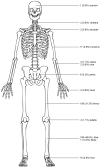Brodie's Abscess: A Systematic Review of Reported Cases
- PMID: 30755846
- PMCID: PMC6367194
- DOI: 10.7150/jbji.31843
Brodie's Abscess: A Systematic Review of Reported Cases
Abstract
Introduction: Brodie's abscess is a form of osteomyelitis. Since its first appearance in the medical literature in 1832, numerous cases have been described. The aim of this article is to provide the first comprehensive overview of published cases of Brodie's abscess, and to describe diagnostic methods, therapeutic consequences and outcomes. Methods: According to PRISMA guidelines a systematic review of the literature was performed. All published data in English or Dutch were considered for inclusion with no limitations on publication date. Data was extracted on demography, duration of symptoms, signs of inflammation, diagnostic imaging, causative agent, treatment and follow-up. Results: A total of 70 articles were included, reporting on a total of 407 patients, mostly young (median age 17) males (male:female ratio 2.1:1). The median duration of symptoms before diagnosis was 12 weeks (SD 26). Mostly consisting of pain (98%) and/or swelling (53%). 84% of all patients were afebrile, and less than 50% had elevated serum inflammation markers. Diagnosis was made with a combination of imaging modalities: plain X-ray in 96%, MRI (16%) and CT-scan (8%). Treatment consisted of surgery in 94% of the cases, in conjunction with long term antibiotics in 77%. Staphylococcus aureus was the pathogen most often found in the culture (67,3%). Outcome was generally reported as favorable. Recurrence was reported in 15,6% of the cases requiring further intervention. Two cases developed permanent disability. Conclusion: Brodie's abscess has an insidious onset as systemic inflammatory signs and symptoms were often not found. Treatment consisted mostly of surgery followed by antibiotics (77%) or only surgery (17%) and outcomes were generally reported as favourable.
Keywords: Brodie's abscess; case report; osteomyelitis; systematic review.
Conflict of interest statement
Competing Interests: The authors have declared that no competing interest exists.
Figures






Similar articles
-
An unusual case of Brodie's abscess in the humerus of an adult female.IDCases. 2024 Apr 27;36:e01977. doi: 10.1016/j.idcr.2024.e01977. eCollection 2024. IDCases. 2024. PMID: 38711946 Free PMC article.
-
Brodie's Abscess of the Humeral Paddle in a Child: A case Report.J Orthop Case Rep. 2024 Oct;14(10):41-44. doi: 10.13107/jocr.2024.v14.i10.4804. J Orthop Case Rep. 2024. PMID: 39381277 Free PMC article.
-
Brodie's abscess following percutaneous fixation of distal radius fracture in a child.Strategies Trauma Limb Reconstr. 2016 Apr;11(1):69-73. doi: 10.1007/s11751-016-0249-3. Epub 2016 Mar 16. Strategies Trauma Limb Reconstr. 2016. PMID: 26984410 Free PMC article.
-
Brodie's abscess revisited.JBR-BTR. 2010 Mar-Apr;93(2):81-6. JBR-BTR. 2010. PMID: 20524516 Review.
-
[Brodie's syndrome. A report of 2 atypical cases].Minerva Stomatol. 1995 Jul-Aug;44(7-8):361-8. Minerva Stomatol. 1995. PMID: 8538583 Review. Italian.
Cited by
-
Post-traumatic Brodie's Abscess of the Tarsal Cuboid: A Case Report and Review of the Literature.Cureus. 2024 Jan 29;16(1):e53158. doi: 10.7759/cureus.53158. eCollection 2024 Jan. Cureus. 2024. PMID: 38420079 Free PMC article.
-
An unusual case of Brodie's abscess in the humerus of an adult female.IDCases. 2024 Apr 27;36:e01977. doi: 10.1016/j.idcr.2024.e01977. eCollection 2024. IDCases. 2024. PMID: 38711946 Free PMC article.
-
Challenges in the Diagnosis of Brodie's Abscess in Subacute Osteomyelitis.J Orthop Case Rep. 2020 May-Jun;10(3):1-4. doi: 10.13107/jocr.2020.v10.i03.1722. J Orthop Case Rep. 2020. PMID: 33954124 Free PMC article.
-
A Rare Presentation of Brodie Abscess in the Clavicle.J Am Acad Orthop Surg Glob Res Rev. 2021 Apr 13;5(4):e20.00249. doi: 10.5435/JAAOSGlobal-D-20-00249. J Am Acad Orthop Surg Glob Res Rev. 2021. PMID: 33848278 Free PMC article.
-
A Rare Case of Brodie's Abscess in the Tibial Diaphysis Masquerading as a Vaso-occlusive Sickle Crisis.J Community Hosp Intern Med Perspect. 2024 Jan 12;14(1):50-53. doi: 10.55729/2000-9666.1299. eCollection 2024. J Community Hosp Intern Med Perspect. 2024. PMID: 38482084 Free PMC article.
References
-
- Harris NH, Kirkaldy WH. Primary Subacute Pyogenic osteomyelitis. J Bone Joint Surg Br. England. 1965 Aug;47:526–32. - PubMed
-
- Metsemakers WJ, Morgenstern M, McNally MA, Moriarty TF, McFadyen I, Scarborough M. et al. Fracture-related infection: A consensus on definition from an international expert group. Injury. Netherlands. 2018 Mar;49(3):505–10. - PubMed
-
- Lew DP, Waldvogel FA. Osteomyelitis. Lancet; 2004. pp. 369–79. - PubMed
Publication types
LinkOut - more resources
Full Text Sources

